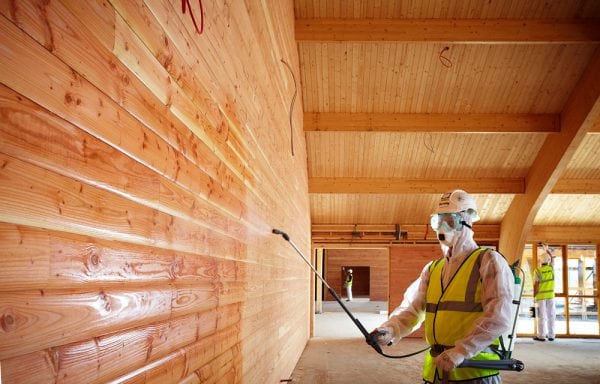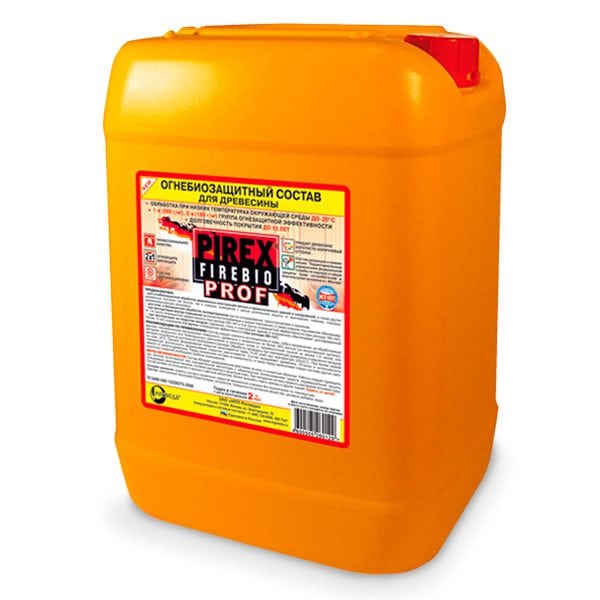Wood is one of the main materials used in construction. The possibilities of using wood are practically unlimited. However, there is a drawback to wooden structures - a high level of humidity leads to their decay. Chemical treatment of wood helps to correct the situation.
- Chemical Processing Options
- Classification of protective compounds
- Processing Features
- Choice of impregnation
- Rules for applying protective equipment
- Additional Information
- Folk ways to combat the fungus

There are several reasons for rotting wood:
- high humidity (over 80%);
- high moisture content of the wood itself (over 15%);
- oxygen stagnation;
- temperature differences;
- condensation accumulation;
- wood freezing;
- permanent contact with the ground.
Chemical Processing Options
The application of chemicals is considered the most popular way of processing wood products. In this case, the main option for chemical treatment is prophylactic impregnation to prevent rotting of the wood and its damage by insect pests. Impregnation includes two stages - conservation and antiseptic.
Conservation is understood as impregnation of the material structure with special substances. Diffusion or autoclave impregnation is used with immersion of wood in containers with different temperature levels.
Modern methods involve preservation in vacuum at elevated pressure. Such compositions are used for processing structures that face difficult operating conditions (sleepers, power transmission poles, piles). The main advantage of processing at high pressure is the maximum penetration of the protective composition.
Antiseptics are a surface treatment of the material that prevents the appearance and development of unwanted microorganisms. The application of antiseptics is carried out in several ways, including:
- a brush;
- from a spray gun (automatic and mechanical spray guns);
- immersion of the product in an antiseptic solution (hot or cold).
The most advanced technologies include mechanochemical woodworking. The process consists in impregnating the material with an aqueous modifier that reacts with wood components during mechanical and temperature activation. Urea acts as a modifier.
to contents ↑Classification of protective compounds
There are three types of chemicals for wood surfaces:
- paints;
- varnishes;
- antiseptic agents.
Staining helps both protect the wood from moisture and give the product a more aesthetic appearance. Water-soluble paints are often used inside buildings, and outside are made on the basis of organic solvents.
Varnishing wood allows you to not only get a beautiful matte or shiny surface, but also create a protective film. In this case, you can save the natural color and its relief of the material. The protective properties of varnishes lie in the fact that fungicides are present in them, preventing the growth of harmful microorganisms and preventing the destruction and fading of wooden products.
Antiseptic materials are especially relevant in cases where the material has already been moldy.
Varieties of antiseptic agents:
- Water soluble antiseptics.They are distinguished by the absence of toxicity, odor and a quick drying time. Water soluble formulations include fluorides, borax, silicofluorides, boric acid and other elements. Such substances are produced both in the form of a ready-to-use solution and in powder form. It is undesirable to use water-soluble substances for surfaces that are in constant contact with liquids.
- Water repellent antiseptics. Such compounds have a strong odor and a more significant penetration into the wood structure. Usually used where there is high humidity (bath rooms, cellars, etc.).
- Solvent-based antiseptics. Applicable for processing both external and internal surfaces. Dries within 10-14 hours.
- Oil antiseptics. Insoluble in water, characterized by a very strong and reliable protective film. They are used to impregnate exclusively dry wood. Not suitable for residential use due to its toxicity.
- Combined antiseptics. Such compositions can be used for processing all types of wood products intended for use in any conditions. A distinctive feature of the combined means is increased fire safety.
According to the level of absorption, antiseptic agents are classified as follows:
- Glaze chemicals. Colorless, do not alter the surface topography.
- Opaque chemicals. Penetrate deep into the structure of the tree. Under their influence, both color and texture of the material change.
When choosing a protective composition should proceed from its purpose and distinctive features. For example, paint and varnish compositions for treating exterior surfaces can easily tolerate high humidity, but may be too toxic for indoor use. Compositions for internal use are usually resistant to mechanical stress, but cannot resist temperature extremes or ultraviolet radiation.
to contents ↑Processing Features
The film formed on a wooden surface reliably protects the material from moisture and pests. However, the main difficulty in processing is the uniform distribution of the protective material over the entire surface. The problem is all kinds of wood bumps. Achieving the desired effect is largely determined by the properties of the chemical - its density, viscosity, humidity and surface activity.
Different types of wood are not equally impregnated. For example, antiseptics are most difficult to process conifers. Also, a high level of resistance to antiseptics is exerted by the deep layers of wood of some deciduous trees, such as oak, birch, ash, elm or beech.
To a large extent, the ability of the raw material to absorb the antiseptic is dictated by its moisture. For this reason, before antiseptic and canning, the material is dried, and only then subjected to chemical treatment.
to contents ↑
Choice of impregnation
The following brands of impregnation are the most popular:
- "Wood healer." Impregnation of this brand can be used to process a variety of wood species at any stage of the lesion. Impregnation is non-toxic, and therefore can be used not only for external but also for internal work.
- "Biox". Impregnation allows you to protect the material from mold, does not violate the texture and surface relief. Under this brand, both color and transparent protective compounds are produced.
- "Biosept." It is characterized by versatility, can be used for decoration of premises for residential and household purposes. The composition of "Biosept" includes biocides of the latest generation.The drug is environmentally friendly, resistant to moisture. Impregnation resistant to flushing and other mechanical influences. Subsequent surface painting is possible.
- "Aquatex". This protective agent is especially suitable for processing lumber and wood products (windows, doors, stairs, etc.).
- Pinotex. Antiseptic agents, paints and oils under this brand are applicable to all types of wood. Effectively prevent surface fading.
- Elkon. Several specialized types of impregnation of this brand are produced. In particular, "Elkon Aqua Bio" is intended for newly made lumber. "Elkon T" is used for machining end parts. "Elkon Sauna" is used to protect surfaces in baths and saunas.
- The well-known Finnish manufacturer - “Tikkurila” - produces antiseptics of all varieties (covering, primer, glaze). Their oil paints for sawn, planed and unprocessed surfaces are also popular.
- The British company “Dulux” is famous for its high-quality organic primers and antifungal protective compounds. Impregnation not only guarantees protection against fungus, but also protects surface damage from exposure to sunlight and moisture.
- The impregnation of the German company "Alligator" is characterized by deep penetration. However, they do not violate the breathability and texture of the material.
Rules for applying protective equipment
It’s easy to work with protective equipment for wooden surfaces. However, first of all, you need to take care of your own safety - to protect your skin and eyes from chemicals in them. To do this, you need a rubber apron, gloves, a respirator and glasses.
Surface Treatment Instructions:
- We clean the surface of dirt, grease, old paint. We use a solvent and a scraper for this.
- Additionally, we clean the surface with sandpaper.
- We wash the surface with warm water and detergent.
- We wait until the tree is completely dry.
- We study the recommendations of the manufacturer of protective equipment.
- We apply varnish, paint or an antiseptic preparation on damaged areas, as well as on the end and trim parts of the structure, as well as cuts.
- The subsequent layers are applied only after the surface has completely dried (2-4 hours). For final drying, it will take from several days to two weeks. The drying time of wood depends on both the specific composition and the level of temperature and humidity in the environment.
Additional Information
In each case, the choice of composition is individual. For processing street buildings (for example, arbors, terraces), difficult-to-wash mortars are used, which, if applied in accordance with the instructions, will last 30 years or more. For rooms with extreme humidity, preparations are needed that are resistant to sudden changes in temperature. For ceilings, windows and doors, impregnations and paints are needed to prevent uneven shrinkage of the material and to prevent cracking of wood.
Fire retardant impregnations are usually effective for no more than 7 years. Then the surface will have to be processed again. However, the actual terms of protection of the coating can vary greatly depending on the climate and nature of operation.
to contents ↑Advice! When it comes time to re-treatment, losing the protective properties of the surface, it is recommended to use a different composition. The second time you should not use the same antiseptic, since the effect of its use will be lower.
Folk ways to combat the fungus
Listed below are a few effective wood decay and mold control agents:
- Silicate glue. The substance is diluted with water to the stage of viscous fluidity.Then the problem areas of the board or product are processed.
- Potassium Dichromate Equal amounts of five percent solutions of potassium dichromate and sulfuric acid are mixed. It is necessary to process not only wooden surfaces, but also the nearby soil to a half-meter depth.
- A mixture of vinegar and soda. Areas affected by mold are sprinkled with baking soda and sprinkled with vinegar.
- Copper sulfate. 100 grams of vitriol is added to a 10-liter water tank. The solution is applied to wooden surfaces.
- Hot tar. It is applied to processing of external surfaces.
- Salt with boric acid. A kilogram of sodium chloride and 50 grams of boric acid are poured into a container with 5 liters of boiling water. The surface is processed several times with 2-3 hour breaks.
Note! Folk methods are effective in the initial stages of decay. If vast areas are affected, chemical treatment cannot be dispensed with by factory means.
Modern technologies can significantly improve the performance of wood. The material will become more durable, less susceptible to the damaging effects of moisture and harmful microorganisms.










